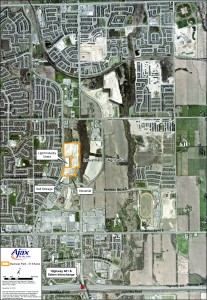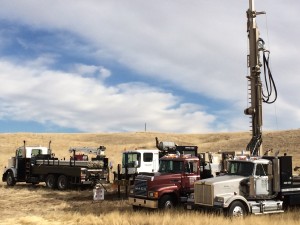
Certified Buildings and Sites Eliminate Risks
03 May, 2015
Caption: Continental Tire announced a $500 million project and 1,700 jobs in October 2011 for Sumter, S.C. The company selected the Gibbs Rail Site, which was certified through the South Carolina Department of Commerce’s buildings program. McCallum Sweeney has partnered with the department for five years on the program, certifying more than 40 sites in the state during that time.
Photo: McCallum Sweeney Consulting
By David Hodes
The site certification process speeds business development.
Getting a chunk of land assembled tends to be the easy part.
But getting an industrial park to work — locating it in an area where all the workforce that individual businesses will need is available, working with local government to secure future expansion potential, getting utilities there, building or adjusting infrastructure including interstates and rail spurs that’s when the heavy lifting comes into play.
All of those due diligence steps take time, patience and careful consideration before any site changes from land that may have been a former soybean or corn field, into land that needs to be a shovel-ready investment that creates opportunities for both the employer jump-starting a startup and the potential employees in nearby towns and cities looking for work.
And, in today’s business climate, all that due diligence involved in getting a site certified has to happen fast.
Paige Webster, owner of Webster Global Site Selectors, says that the No. 1 criteria they look for in site selection is the quality of workforce in the region. “Labor is such very high overhead cost to these corporations that want to locate in an industrial park,” he says. “And when I say labor, it’s not just wages and unemployment and underemployment of communities or regions. But it is also the workman’s compensation agreements in a state or region. And that is what we are analyzing as well.”

The 41.9-acre business park in Ajax, Ontario, Canada, was the first park certified under the PriorityProperty, Ontario’s first municipal certified site program. Photo: Town of Ajax
Today’s Standard Operating Procedures
Using consultants for site certification is becoming standard operating procedures (SOP) in many areas of the country. Wyoming’s officials have completed their first site certified — a 26-acre parcel in the Sheridan Hi-Tech Business Park in Sheridan that’s owned by the Sheridan Economic and Educational Development Authority. There are an additional 300 acres adjacent to the park for possible expansion.
The certification process was conducted by McCallum Sweeney Consulting (MSC) of Greenville, South Carolina, where a majority of their business is certification of sites.
MSC has one of the most comprehensive site certification programs in the world. The company has consulted on certified sites all across the world for companies such as Comcast, Harley-Davidson, Nissan Motor Co., Mitsubishi Motors, The Boeing Co., and dozens more. They had been working for more than a year on that Wyoming project.
More and more people are getting comfortable with certification being a worthwhile expenditure, says Mark Sweeney, senior principal of MSC. “What has become more critical now is once a company decides on a site, they want to get certification done in the minimum time possible,” he says.
Sweeney says that these economic development organizations or company owners want to select a property that is fully vetted, with all the information they need available immediately. “In other words, they want as much certainty around the location and the property choice as possible. And that is really what is driving this certification process.”
Colorado’s Niobrara Project is Game Changer
By Rachel DuranA 667-acre site in Weld County, Colorado, is located at the nexus of some of the most abundant and cheapest natural gas resources in America (Cheyenne, Wyoming’s hub), and one of the five largest transcontinental fiber-optic rings in the country.
Drilling of groundwater wells at Niobrara Energy Development in Weld County. Five wells have been drilled, with all successfully producing industrial water. Photo: Niobrara Energy Development
Craig Harrison, developer of the Niobrara Energy Development, has spent the past five years taking the risk out of doing business at this Weld County site, which is billed as “where traditional energy meets the microgrid.” Microgrids are self-contained power systems located in small areas, which feature a power plant, and increasingly the generation of and storage of renewable energy.
Harrison, founder of the Niobrara Energy Park LLC and owner of the Harrison Resource Corp., has 150 documents in hand from organizations such as chief engineer at the site, CH2M Hill, which details the site’s shovel-ready advantages, including environmental waivers granted by the county. What’s more, the development has been approved by Colorado’s public utility group for the establishment of a natural gas utility.
“If you want to build to build a $300 million natural gas power plant, it is all administrative review because there are no public hearings,” Harrison says. “This is unheard of. If you want to build a 1 million-square-foot data center and are ready to apply for building permits, it will be strictly administrative review.”
The Niobrara site is approved for 52 different uses for now.
The development also features a secure water source, supported by both water resources captive within the site and options on water resources at an adjacent ranch. Companies locating to the site are eligible to apply for a property tax abatement incentive from the county, which is among the only counties in the country that do not have short debt or long-term debt, thanks to capital investments in the billions of dollars to develop the nearby Niobrara shale oil play.
Harrison says commissioners welcome the Niobrara project because it calls for taking the area’s surplus natural gas and turning it into electricity for consumption at the development, as opposed to shipping it out of the area.
For complete details, visit www.niobraraenergypark.com.
Creating Certainty
Lindsey Myers, senior consultant for MSC, says that one of the changes in certification that has happened during the last few years is about that certainty. “It used to be that if you didn’t have something in place for the site, it was enough to have a schedule to get it there,” she says. “And not what the schedule was. Now, they have put into place time frames. Speed to market is what our corporate clients want, and we are seeing that certification needs to be a match to that desired speed.”
Speed to market is what has helped companies like Volkswagen Group of America, for example, get into a site certified by MSC at the 1,400-acre Chattanooga, Tennessee plant, enabling the company to meet or exceed production schedules without any surprises that they may have been used to in the past, Sweeney says.
Sometimes, the popularity of an industrial park can be a good thing.
Lisa Collins, director of economic development for Cook County (Ga.) Economic Development Commission (CCEDC), says that Cook County had a very successful industrial park, but it was full. The CCEDC began to put parcels together which would eventually become the 3,000-acre South Georgia megasite, featuring good frontage access to Interstate 75, adjacent to both state highway 41 and the Norfolk Southern rail line.
The CCEDC worked with partners to certify 350 acres as Georgia Ready for Accelerated Development (GRAD) sites, meaning that these acres were site ready. Due diligence qualifications for GRAD include ownership security, zoning designation, road and rail accessibility, utilities service, and wetlands and stream delineation.
“A company can come in now and all of that permitting has been done, all the zoning is done,” Collins says. “So we really believe that we have a strong industrial park to market.”
Overcoming Obstacles, Tracking Trends
But site certification specialists and consultants have more to deal with than just the physical location of the site. “Most of the obstacles we face are about perception,” says Cliff Krut, economic developer for Florida First Sites (FFS). FFS is a site certification program working with MSC on due diligence. “Florida is not a place where you see a lot of manufacturing,” Krut says. “You see information technology and tourism. Decision makers think that Florida is just for vacationers, and that is a hindrance.”
Krut says that most of the tenants or owners of industrial sites in this part of Florida are military defense related, due to the fact that there are seven military installations in northwest Florida, and an Air Force Base at Hurlburt Field, which is part of Eglin Air Force base.
Some of the companies that had been traditionally doing defense work are now looking for commercial aviation opportunities, as aircraft manufacturing continues to migrate to the Southeast, Krut says. “Commercial aviation is an opportunity where we see a future in northwest Florida. We see our certified site program as maybe a place where that growth can occur, as well as the unique prospects of attracting new international companies that may be considering locating closer to where this aircraft manufacturing has migrated.”
In Florida, the presence of wetlands requires some potentially time-consuming litigation, Sweeney says. “That is the biggest issue we see most frequently in the state. Given the fact that the whole state is barely above sea level.”
Both Florida and California have strict development regulations, Sweeney says, and therefore tend to be developer controlled. But in the Midwest, regulations are not as rigid.
One of the largest certified sites in the country is in the Midwest — the 1,660-acre Mid-West Mega Commerce Center in Ohio.
Certification for this site came through the partnership with Enterprise Advisory Group in Columbus, Fayette County Economic Development, the Austin Consulting Group Inc. in Cleveland, and the state of Ohio, which provided $4.3 million for infrastructure upgrades.
The site is located within a 45-minute drive from Columbus and Dayton. The site is at the intersection of two four lane highways — Interstate 71 to the west and U.S. Route 35 to the south — making it accessible to a workforce from those bigger cities. It’s also in an unincorporated area which means there is no income tax. “I think it’s appealing from the cost of doing business, when you have a ready workforce and no income tax on the land,” says Jamie Gentry, the Ohio economic development specialist for Enterprise Advisory Group.
Gentry says that there is a rail spur that comes up to the border of the site, and that they have permission from the Ohio Department of Transportation to extend it into the site. “But we have not done that because we didn’t want to dictate where the projects can go,” he says. “We like to build a sort of blank canvas to the client and have them tell us where they want the rail to go.”
Partnerships to Streamline the Process
Then there are government entities to deal with — not always a bad thing if you do your homework, as Webster Global encountered when certifying a site in the town of Ajax, Ontario in Canada. “Typically, after the objective analysis, you start looking at more subjective things, like the quality of life in the community, housing for executives, a university in place, job training opportunities,” Webster says. “Because our jobs are on the line if we make the wrong decision for these companies.”
Webster says this kind of due diligence just escalates the property to the next level, as it did for Ajax. “Ajax economic developers went ahead and hired Webster Global prior to when the province did their certification, Webster says. For the economic developer to submit that property as certified there was only one document that the province required that we didn’t require. So it was quickly completed and certified at the provincal level.”
There are no perfect sites, Sweeney says, explaining that if there is a big archaeological find on a piece of land, for example, and it’s on the corner of the property that may not be developable anyway, they would cut that out from the certification process. “We find challenges all of the time,” he says. “So the idea is to find out your challenges ahead of time and find a solution to them so when a prospect comes in they don’t discover that six months later in their development stage.”
Some businesses looking at industrial park sites, like data centers, are more demanding than others. Data centers are not people intense, Sweeney says. “But they are energy intense and risk aversion intense.” They need massive amounts of electricity and available water — plus a location that is away from any kind of vibration risk whether it’s natural disaster, like an earthquake, or railroad activity or mining activity. “There is a site certification niche for that industry that has evolved recently, certifying these highly specialized sites for data centers,” Sweeney says. “But not for food processors yet, who are heavy water and sewer users.”
For more details, visit
Cook County (Ga.) Economic Development Commission
Fayette County (Ohio) Economic Development
Mid-West Mega Commerce Center (Ohio)












